Australia's Newest National Park Is Home to Dramatic Scenery, Incredible Wildlife, and the Oldest Fossils in the World — How to Visit
Here's everything you need to know before visiting Nilpena Ediacara National Park in South Australia.
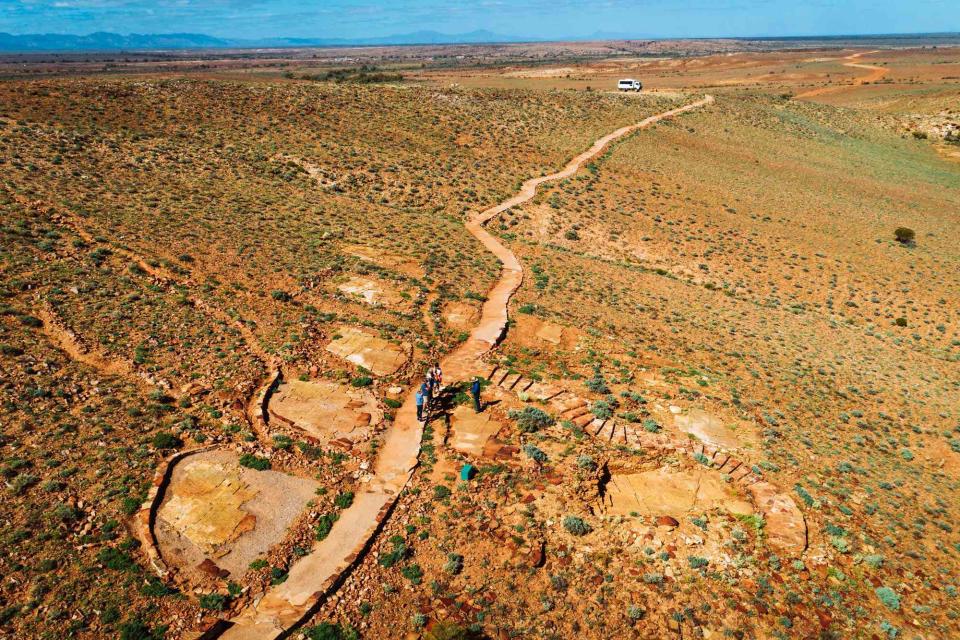
Courtesy of Nilpena Ediacara National Park
More than 540 million years ago, what is now South Australia’s outback was part of the continent’s thundering coastline. Along its edge was a shallow seabed teeming with strange, alien-like creatures — the first life forms on our planet.
As waters receded and lands rose, generations of creatures became trapped and buried in the sediment over time, creating a paleontological lasagna just waiting to be discovered. In 1946, geologist Reg Sprigg was the first to find these ancient fossils, some of the oldest ever recorded, in the Ediacara Hills.
“It is probably the best Ediacara fossil site in the world,” says Kym Geue, the ranger in charge of Nilpena Ediacara National Park. “There are only around 60 places in the world that have Ediacara fossils, but we have the most diverse groups of animals. Elsewhere, you might be looking at a few individual specimens, but here, we’re pulling out whole sections of the sea floor and piecing it back together like a big jigsaw puzzle.”
More than 75 years after the first discovery, dozens of fossil beds have been unearthed at what is now Nilpena Ediacara National Park, revealing whole ecosystems containing tens of thousands of preserved specimens. The ongoing discoveries have led the national park to play an important role in the Australian government’s current bid to have the surrounding Flinders Ranges area recognized as a UNESCO World Heritage Site.
While the relatively recent discovery in the Flinders Ranges has excited scientists, this vast landscape has been home to the Adnyamathanha people for countless generations.
Kym Geue
Kym Geue is a tour guide and ranger in charge of Nilpena Ediacara National Park.
Charles Carlow is the founder of Arkaba Homestead, a former sheep station that now serves as a private wildlife conservation area and luxury stay at the edge of Ikara-Flinders Ranges National Park.
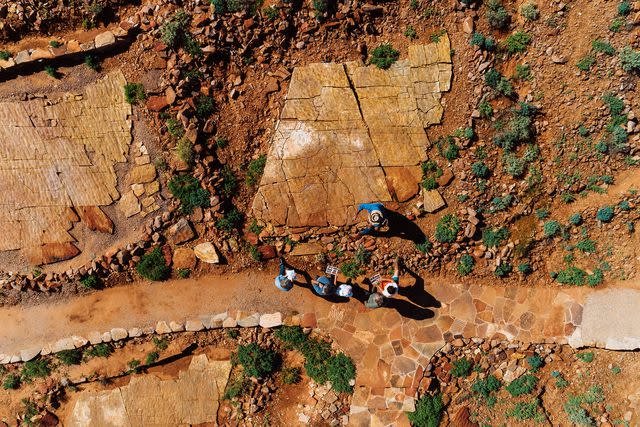
ROBERT LANG/Courtesy of Nilpena Ediacara National Park
Planning Your Visit
Unlike most other Australian national parks, which are free to enter and permit camping or unguided exploration, Nilpena Ediacara National Park is only accessible on a guided tour, which starts from AUD 80 ($53 USD).
Tours
There are two different tours — one in the morning and one in the afternoon.
The Ediacara Experience is a two-hour guided tour of the park with a ranger, taking in the historic woolshed and the former Blacksmith’s Shop. The latter has been converted into a state-of-the-art interpretation center featuring an original nine-meter-long fossil bed you can touch with animated displays that bring the Ediacara animals back to life. This tour runs from 9:30 a.m. to 11:30 a.m. on Monday, Wednesday, and Saturday.
The 3.5-hour Fossil Field Exploration tour encompasses the same areas as the Ediacara Experience, but with the addition of visiting an active research site at the fossil beds. This tour runs from 12:30 p.m. to 4 p.m. on Monday, Wednesday, and Saturday.
Both tours are in high demand and rangers recommend buying tickets online, at least one week in advance to avoid missing out. Tours depart at the national park’s gateway, which is marked by a stone wall. Parking is available at the gateway.
Because the national park is an active research site, and the environment is sensitive, there are no hiking trails, recreational facilities, camping amenities, or food and drink providers. Bring drinking water and packed food, and take any trash with you when you leave.
Amenities
Toilets, including accessible ones, are available at the visitor precinct. Assistance dogs are permitted in the park, but must be appropriately restrained.
Visitors with mobility, visual, or hearing needs, or who speak English as a second language and require translation, should contact National Parks and Wildlife Service South Australia ahead of time for more information.
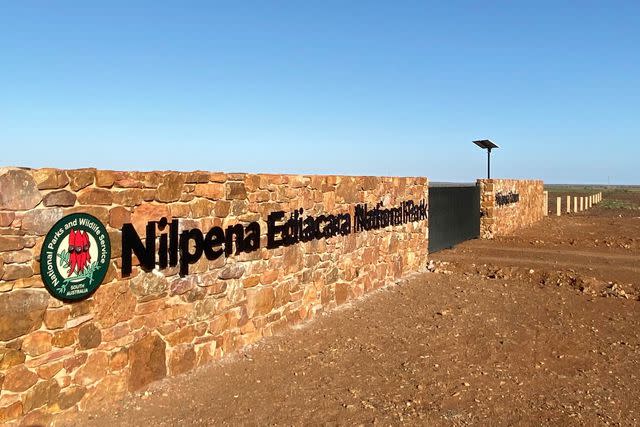
Courtesy of Nilpena Ediacara National Park
How to Get There
Nilpena Ediacara National Park is located about 311 miles, or a six-hour drive, from Adelaide, the capital city of South Australia. You can also catch a regional flight from Adelaide to Port Augusta Airport and then drive three hours.
There's no public transportation available, so you'll need to hire a car from Adelaide or Port Augusta to reach the park or book a packaged tour. If renting a car, Carlow recommends booking one with higher clearance, as lower vehicles are more prone to becoming stuck on dirt roads. You'll also want to check whether your car insurance covers off-road driving.
How to Navigate the Park
Some tour operators, like Wallaby Tracks Adventure Tours and Walk Into Luxury, offer packaged tours from Adelaide that include transport, accommodations, and visits to both Nilpena Ediacara and Ikara-Flinders Ranges national parks.
Self-drive
While many stick to the coastal route from Adelaide to Port Augusta, and then continue to the Flinders Ranges, a more scenic and palate-pleasing drive north is via the Clare Valley, one of Australia’s oldest wine regions.
“It produces some of the best riesling in Australia and was settled by Cornish tin miners, so there’s plenty of beautiful stone architecture to admire,” says Carlow. Award-winning Skillogalee Estate has a cellar door and restaurant housed in a historic cottage overlooking the vines, while Pikes has both a winery and brewery.
For a bite on the road, Carlow recommends stopping for pie at Stone Hut or North Star Hotel, one of the most historic pubs in the area. Stop in Quorn to sample artisanal gin infused with native botanicals at Flinders Gin. From Quorn to Hawker, you’ll drive across the spectacular Willochra Plain and see colonial ruins scattered by the roadside.
Approximately 90 minutes from Nilpena Ediacara National Park, Hawker is one of the area’s larger townships, with a service station, mechanic, hospital, general store, and the best place to restock on provisions, including water.
If you plan to drive, keep in mind not every town has a gas station, and you'll be navigating dirt roads in some areas. Avoid driving at dawn and dusk, as wildlife is most active at these times and kangaroos are notorious for appearing unexpectedly on the road, resulting in collisions.
Best Time to Visit
The best time to visit Nilpena Ediacara National Park is from April to October, when the weather is milder. Temperatures generally reach 61 degrees Farenheit during the day and 39 degrees at night in July.
“June and July are pretty dry, but the weather becomes more unstable toward September and October. It’s a very low and exposed area, so it can get quite windy,” says Geue.
Even though it may be cool, it’s still a good idea to wear sunscreen as Australia’s sunlight can be intense. During the summer, maximum temperatures can reach up to 113 degrees Farenheit, which is why Nilpena Ediacara National Park is closed from Dec. 1 through March 15 each year. This is also when the park receives intense thunderstorms that turn the area into a bog.
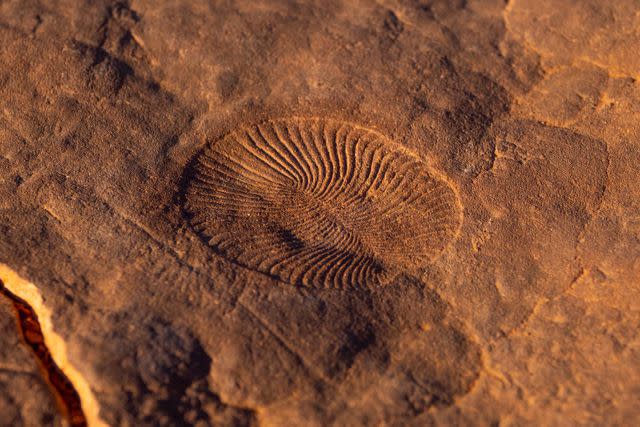
Courtesy of Nilpena Ediacara National Park
Best Things to Do
Alice's Restaurant Bed
In the late 1960s, American folk singer Arlo Guthrie crooned about being able to get anything you wanted at Alice’s Restaurant. When palaeontologist Dr. Mary Droser and her team from the University of California discovered a unique fossil bed in the national park, they decided to name it after Guthrie’s song.
Visitors can see Alice’s Restaurant Bed, comprised of 500 different pieces, inside the Blacksmith’s Shop. Audiovisual projections bring the fossils back to life and visitors are able to create 3D casts of the creatures using putty.
Fossil Fields
During a guided tour, visitors explore the quarries where palaeontologists are currently working to extract more Ediacaran fossils from the rock. Palaeontologists are on site only a handful of months of the year, but if you’re lucky, you may see them. If not, your guide will walk you through the rippled layers of organic matter, explaining the delicate work being done to preserve these tiny fossils.
Ikara-Flinders Ranges National Park
Neighboring Ikara-Flinders Ranges National Park makes for a natural extension on any trip to Nilpena Ediacara National Park. While Nilpena Ediacara National Park is flatter and more open, Ikara-Flinders Ranges National Park is home to sprawling mountain ranges and grasslands. Here, you’ll find many hiking trails, campgrounds, and historic stations that were transformed into luxury lodgings at the edge of the park.
Wadna
Kristian Coulthard, owner of Wadna, is an Adnyamathanha guide who runs walks through Ikara-Flinders Ranges National Park, including to Dingley Dell, an ancient petroglyph site that features engravings dating as far back as 40,000 years ago. Coulthard shares his knowledge of the region’s plants and native foods, as well as cultural stories handed down for generations. Visitors can also browse carvings, jewelry, bush medicines, and artworks for sale.
Best Hikes
Ikara-Flinders Ranges National Park has four walks and 14 hiking trails. Some of the easier walks include Hills Homestead Walk, which visits a pioneering heritage inside Wilpena Pound, and the Living With Land Walk.
The more moderate Arkaroo Rock Hike passes Adnyamathanha rock paintings and tells the creation story of Wilpena Pound.
Wilcolo Creeks Hike is a self-guided, 5.7-mile loop to a lookout point, where you’ll find signage explaining the geological significance of the area and how it was formed. The whole trek takes about five hours.
Wildlife
Yellow-footed Rock Wallaby
Various species of macropods call the plains home, including red kangaroos, western grey kangaroos, and wallaroos, but the yellow-footed rock wallaby is the biggest conservation success story for the Flinders Ranges. The best place to see them is Brachina Gorge, home to a large mob.
“They were almost hunted out of existence in the 1920s and their population was affected by introduced and feral animals,” says Geue. “The authorities have done a lot of work to reduce feral animals and in the last 20 years yellow foot rock wallabies have bounced back.”
Birds
Natural spring water in the creeks acts as a magnet for birdlife, with some of Australia’s most colorful and unique species flocking to feed and breed in the Flinders Ranges. This includes the country’s largest bird of prey, the wedge-tailed eagle, as well as smaller species like fairywrens, mulga parrots, kingfishers, and swallows. The area is particularly known for its large populations of emus.
Bearded Dragons
Usually spotted sunning themselves on the side of the road or from an elevated perch, the bearded dragon is a small reptile with distinctively spiky scales under its chin. When startled, the lizard will open its mouth and puff out its beard to appear larger.
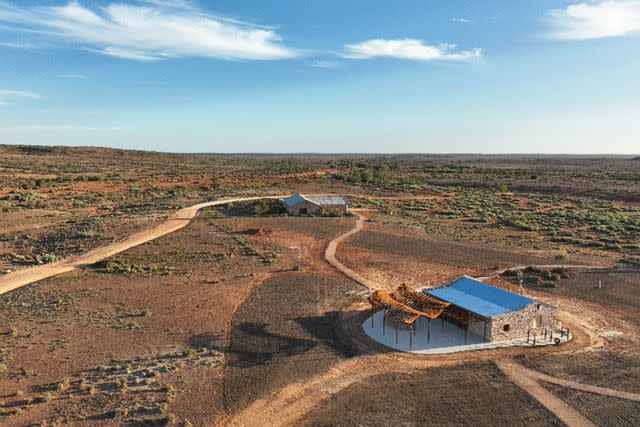
Morgan Sette/Courtesy of Nilpena Ediacara National Park
Campgrounds
There are no accommodations in Nilpena Ediacara National Park, but there are options in the surrounding towns. Pastoral stations are a defining feature of the region’s history, with many now converted into luxury stays.
Beltana Historic Town
The closest campgrounds to Nilpena Ediacara National Park can be found in Beltana, about 45 minutes away. There are six RV or tented sites available, with showers, toilets, a free barbecue in the community park, and potable water for sale.
Ikara-Flinders Ranges National Park
There are 10 campgrounds available here, with some accessible only by foot and others permitting differing numbers of two-wheel-drive and four-wheel-drive vehicles. Camping fees apply and sites must be booked before arrival.
Wilpena Pound Resort
Wilpena Pound Resort offers 40 powered sites suitable for caravans, campervans, camper-trailers, and tents, as well as 300 unpowered bush campsites. There are also safari-style glamping tents and fully furnished resort rooms for singles and groups up to five. On-site facilities include toilets, showers, fuel, a visitor information center, an ATM, internet access, laundry facilities, a swimming pool, and a general store.
Hotels and Stations
Prairie Hotel
The land that now forms Nilpena Ediacara National Park previously belonged to Prairie Hotel owners Ross and Jane Fargher, who protected the fossil fields and ran tours in the area until agreeing to hand over the land to government management. Visitors can find more fossil information at the hotel, in addition to stylish, country-chic rooms.
Rawnsley Park Station
A former sheep shearing station, Rawnsley Homestead now offers luxurious, self-contained accommodations for couples and families.
Arkaba Homestead
Accommodating up to 10 guests, all-inclusive Arkaba Homestead offers daily guided safari experiences and premium dining. The five-day self-drive Fauna, Fossils, and Food of the Flinders package includes two nights at Arkaba Conservancy and two nights at Prairie Hotel, with a scenic flight over Wilpena Pound.
Places to Eat
There are no dining options inside Nilpena Ediacara National Park, so you’ll need to plan ahead by packing lunch, visiting a nearby town supermarket, or heading to a restaurant at one of the surrounding stations.
Prairie Hotel
“They're renowned for their food,” says Geue. “Everyone goes there for the ‘Feral Feast’, where they cook up goat, camel, emu, kangaroo, all those sort of things.”
Flinders Food Co
This rustic outback eatery has all the verve and style of an urban cafe. The menu here is inspired by native ingredients like quandong, myrtle, and saltbush, with options for lunch and dinner.
Woolshed Restaurant
Rawnsley Park Station’s on-site restaurant showcases local suppliers from across South Australia, with signature lamb tasting dinners starring lamb farmed on the property.
For more Travel & Leisure news, make sure to sign up for our newsletter!
Read the original article on Travel & Leisure.


